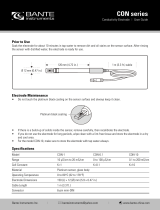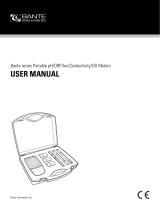
PC850 Version 1.0
taking a measurement. For general accuracy (≥±0.1pH), the meter can be calibrated and used for
approximately one week before the next calibration.
The meter must be recalibrated in the following situations:
(a) New probe or probe that has not been used for a long time
(b) After measuring acid (pH<2) or alkaline solutions (pH>12)
(c) After measuring a solution that contains fluoride or a concentrated organic solution
(d) If the solution’s temperature differs greatly from the calibration solution temperature
4.3. pH Meter Calibration (with an example of three-point calibration)
4.3.1. First point calibration
(a) Press key to enter into the calibration mode, “ CAL 1 ”
blinks at the top right of LCD and “7.00 pH” blinks at the bottom right of
LCD, indicating using pH 7.00 buffer solution to make the 1st point calibration.
(b) Rinse pH electrode in pure water, allow it to dry, and submerge it in
pH7.00 buffer solution. Stir the solution briefly and allow it to stay in the
buffer solution until a stable reading is reached. When stable icon
displays on LCD, press key to calibrate, then 1st point calibration is
finished, the meter enters in measurement mode of one-point calibration.
Calibration guide icon displays at the bottom left of LCD. See Diagram-6.
4.3.2. Second point calibration
Press key to enter into the calibration mode, “ CAL 2 ”
blinks at the top right of LCD indicating to make the 2nd point calibration.
Rinse pH electrode in pure water, allow it to dry, and submerge it in
pH4.00 buffer solution. Stir the solution briefly and allow it to stay in the
buffer solution until a stable reading is reached. The meter’s display will
show scanning and locking process of calibration buffer solution at the
bottom right of LCD. When the meter locks 4.00 pH, stable icon displays
on LCD, press key to calibrate the meter. LCD will display electrode
slope of acidity range, then 2nd point calibration is finished, the meter enters in measurement mode
of two-point calibration. Calibration guide icons display at the bottom left of LCD.
4.3.3. Third point calibration
Press key to enter into the calibration mode, “ CAL 3 ” blinks at the top right of LCD indicating
to make the 3rd point calibration. Rinse pH electrode in pure water, allow it to dry, and submerge it in
pH10.01 buffer solution. Stir the solution briefly and allow it to stay in the buffer solution until a stable
reading is reached. The meter’s display will show scanning and locking process of calibration buffer
solution at the bottom right of LCD. When the meter locks 10.01pH, stable icon displays on LCD,
press key to calibrate the meter. LCD will display electrode slope of alkalinity range, then 3rd

























